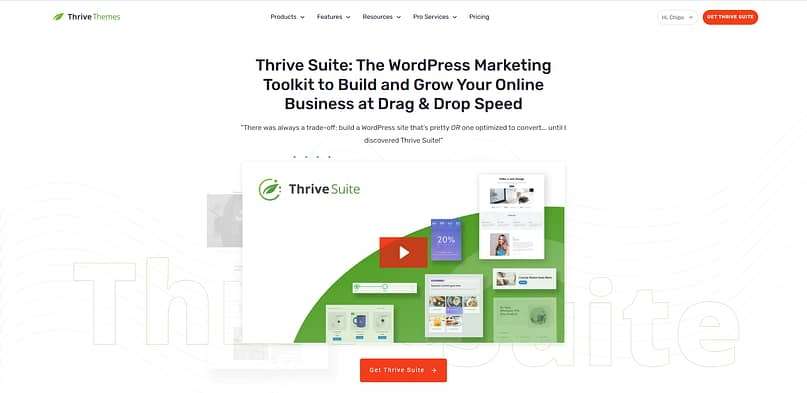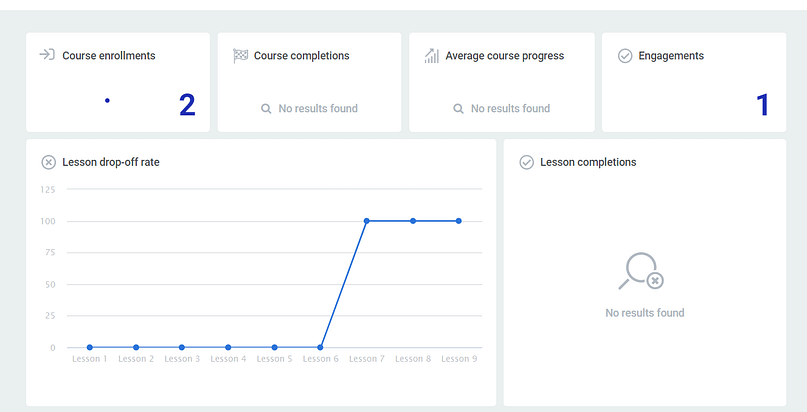TL;DR: How to Teach Online Without Losing Control, Your Voice, or Your Vision
If you're trying to figure out how to teach online in a way that actually works for your students and your business, this guide walks you through every essential step.
Quick tips to get you started:
- Start with outcomes. Define what your students should do by the end, not just what they’ll “learn.”
- Don’t overinvest in gear. A quiet room and a decent mic beat a flashy setup with bad audio.
- Use drip scheduling. Releasing content over time boosts completion rates and keeps students engaged.
- Plan for interaction. Cohort learning, discussion prompts, and feedback loops turn passive students into active participants.
- Own your platform. If you want full control over pricing, design, and your student list, skip the marketplaces.
Ready to dive deeper into tools, strategy, and what actually makes online teaching work? Let’s go.
Online teaching is on the rise and the growth isn't slowing down.
The industry is projected to hit a whopping $457.8 BILLION by 2026. It's one of the fastest-moving digital industries out there!
But how do you get your slice of the pie?
That's why you're here, right? To find a way to teach online and make a steady profit, too?
I'll be straight with you: the space is crowded. Audiences have strict standards. And don't get me started on AI...
As a marketer who's had her fair share of breaking into competitive niches, I know where you are right now and I'm here to help.
If you actually want to build something solid (something that delivers real value and brings in real income) you need a plan.
This guide breaks it down step by step.
Why Trust This Guide?
I’ve spent the last three years at Thrive Themes creating educational content for thousands of course creators; answering their questions, seeing what trips people up, and learning what actually works in the real world.
Beyond that, I’ve helped clients build and sell their own online platforms, and I’ve taught online myself — both as a coach and course creator. So this isn’t guesswork. I’ve seen the messy middle, the tech struggles, the strategy gaps, and the small shifts that make a big difference.
This guide pulls all of that together, so you can skip the noise and focus on building something that works.
More...
Benefits of Teaching Online: Why It’s Worth Starting Now
Teaching online isn’t just a smart way to scale your income — it’s one of the most flexible and sustainable paths to building a brand that grows with you.
Plenty of coaches use it to move beyond one-on-one sessions. Many entrepreneurs build entire businesses around it. And the best part? You don’t need a massive audience to start — just something worth teaching and the right tools to deliver it.
While there are several LMS plugins available on the market, the one we recommend – – is .
If that’s what you’re after, you’re in the right place. Let’s walk through the different ways to make it happen.
How Online Teaching Works: Key Models and What to Expect
There are three main ways to approach teaching online:
- Offering courses through your own WordPress website using a Learning Management System (LMS) plugin.
- Online teaching platforms
- Online course marketplaces
If you’re looking for a solution that offers full control over every aspect of your infoproduct business, then our recommendation is to offer courses on your own WordPress website. However, online teaching platforms and course marketplaces aren’t without their merits.
Let’s get started by discussing how to create courses on your own website.
How to Build an Online Course Business on Your Own Website
All online businesses need a website, and WordPress is the free and flexible Content Management System (CMS) that many entrepreneurs decide to use.
Although WordPress was primarily designed as a blogging platform, with the right Learning Management System plugin, it can also be used as a teaching platform to deliver access-restricted lessons and learning resources to students.
In fact, using WordPress to build and sell online courses on your own website (and start your own business) is the only solution among the three in this article where you have full control over your teaching career.
You’ll have complete control of:
- Who your courses are marketed to
- How your courses are marketed
- The price of your courses
- When to run sales and discounts
- The format of your course material (text, audio, video)
- The visual design of your course website
- The contact information for your students
- Course evaluation methods
- Reporting and analytics
- Teaching in cohorts or on an individual basis
- Drip scheduling course material
The Benefits of Thrive Apprentice
Thrive Apprentice is an online course creation tool that lets you create engaging and comprehensive learning modules right on your own WordPress website. Its intuitive user interface enables even beginners to easily and quickly design professional, captivating courses.
Sound like something you could use in your business?You can create text-based, audio, or video lessons, provide supplementary resources, and even incorporate quizzes to test your students' comprehension levels. Plus, Thrive Apprentice's extensive reporting and analytics feature helps you monitor your students' progress and gain insights into their learning habits.
You also have the freedom to offer different teaching styles. Engage with students individually or conduct lessons in cohorts; and with drip scheduling, you can release your course materials over time.
In essence, using Thrive Apprentice with WordPress allows you to be in the driver's seat, steering your online course business towards success.
“In just 1 day I created everything I needed to sell my courses.”
- BeHappy, Thrive Apprentice Customer
Thrive Suite and the Added Benefits of Being Independent
No WordPress LMS plugin matches the online business power or design flexibility that Thrive Apprentice offers. But what if you need more?
Thrive Apprentice can be purchased by itself, but for those looking for the ultimate online business solution, it also comes bundled with several other online business building WordPress tools inside Thrive Suite. From crafting high converting sales funnels with Thrive Architect, to building a fully customized WordPress theme with Thrive Theme Builder, to visually creating online courses you can sell with Thrive Apprentice — Thrive Suite has everything you need to build, market, and grow your online business.

Pretty cool, right?
What sets Thrive Suite apart is its integrated approach. The tools within the suite are designed to work together, offering more advanced options for your business and marketing strategies. For instance:
- Once a student completes a Thrive Apprentice lesson, you can present them with a time-limited discount for another course.
- During an online course launch, you can display countdown timers on your website and blog posts to remind visitors of the limited-time opportunity.
- You can offer the first module of your online course as a free lead magnet to encourage email list signups. To continue the course, students must pay for access.
Should You Join an Online Teaching Platform? Pros and Cons
Online teaching and tutoring platforms are growing at a rapid pace.
Teachers of all experience levels can make money online. Popular domains include language learning, secondary subject tutoring and further education.
These platforms also help you create an online teaching space, provide materials, and offer regular feedback to improve your performance as a teacher. If you’re looking for an easy way to get started as an online teacher without the hassle of setting up any tech, then joining a teaching platform might be the right choice for you.
To join, you’ll have to prove that you're knowledgeable in your field and have strong teaching abilities. Before you are approved, expect to do a trial lesson. This could be live or recorded.
Here are some of the most reputable companies on the market:
Tutor.com
A one-stop-shop for after-school tutoring. This facilitates private tutoring in all U.S. secondary school subjectsTutorMe
A highly accredited tutor-matching service with a vast range of subjects ranging from coding to chiropracticsWize Prep
Offers tutor services for all secondary school and university subjects with a comprehensive teacher training program
While teaching platforms handle the technical aspects of setting up a course, they typically come with their share of drawbacks. One primary concern is limited control over pricing and content of your services, potentially hindering your earnings and teaching style. These platforms also take a commission from your fees, which can significantly reduce your income.
Teaching on Course Marketplaces Like Udemy or Skillshare
If you don't want to work for an online teaching platform, what other options are available to you?
Often course creators decide to build and sell their info-products through online course marketplaces like Udemy, Skillshare and Udacity. These marketplaces are convenient because they offer a built-in audience, so there’s no need to build fancy marketing funnels to attract students.
But even though these course marketplaces make it easy to build and launch online courses, the convenience they provide comes with some serious drawbacks for your online business. Most notably:
- The marketplace gives you limited control over your course pricing. On top of that, the marketplace can discount your courses as they wish and always take a significant percentage of your revenue for the honor.
- You have limited control over your marketing as your courses are forced to compete among the sea of competitors in your niche — all fighting for customers with race-to-the-bottom pricing
- You do not get access to your student email list. This means you have NO way to contact your students directly, making it near impossible to create a lasting and recurring revenue relationship with your course customers.
To avoid these drawbacks, consider offering online courses on your WordPress website instead, using a feature-rich LMS such as Thrive Apprentice.
How Much Can You Make Teaching Online? (Realistic Numbers)
It’s probably MUCH more than you think.
When you teach online courses independently — on your own WordPress platform — you get to set your own prices.
And, if your course solves a big problem for people, you can set that price high.
How high?
A reasonably priced, high-value course can easily sell for around $200. And if you can achieve the very realistic goal of selling just one course per day, that equates to a yearly income of ~$73,000.
Make a second course that achieves the same success, and your online course business is now well over the six-figure mark — income you’d never dream of making when teaching on online platforms owned by others!
Pro tip
Curious to learn how you can create and sell a reasonably priced online course for $200? Check out From 0 to 20 Students, our free course that will walk you through how to build an online course business — step-by-step.
By contrast, joining a teaching platform typically means you'll get paid an hourly rate — set by the platform (not you!) — so you’ll never get compensated what your teaching is actually worth. The same principle holds true for selling your courses on online course marketplaces.
Do You Need Certifications to Teach Online?
Some niches – particularly those taught by colleges and universities – may require some kind of certification. However, for the entrepreneur teaching subjects such as drawing, video editing, or online marketing, certifications are typically not required.
Many teaching platforms see teaching certifications as another way to affirm the quality of education you offer, but not all require them. However, as we’ve discussed already, there are many ways to teach online from home that don't require any certificates.
How to Build Credibility as an Online Teacher
It's important to know that students are more likely to hire teachers with experience and the testimonials to back any claims of experience up. And getting great testimonials, simply put, comes from being a great teacher. (Need help gathering and displaying testimonials? Try Thrive Ovation.)

With great teaching, comes great testimonials to support your online business
If you haven’t worked to develop strong teaching skills, it will show.
And here’s a little secret: both great teaching and salesmanship are more similar than you think.
To sell your expertise effectively, work on mastering the art of communicating your ideas, and breaking complex things down in ways that can be clearly understood.
How to Teach Online Successfully: 8 Essential Tips to Prepare
Your biggest advantage as a teacher is that no one else can teach quite like YOU can.
Your personality, approach, and style are what set you apart from other people that teach your subject. Your uniqueness is your strength.
To this end, it’s important to know what you enjoy teaching, what you teach well AS WELL AS what you don’t.
Infuse your teaching with your own personality and you’ll uncover unique ways of conveying your expertise to others effectively — allowing you to become the master of teaching online your way.
If you still aren’t confident in your teaching abilities, check out our free course 8 Hacks to Become Better at Teaching Online Video Courses, where you’ll learn clever tips on how to become super comfortable teaching on camera, no matter what online teaching avenue you decide to pursue.
Plan Your Course
- Define Course Outcomes and Student Transformation
- Structure Modules for Clarity and Progress
- Choose Formats That Match Learning Styles
A course is taught over several lessons. Each lesson needs to have its own goal and clearly contribute to delivering the desired outcome of the course.
A well-planned course includes:
- Clearly defined modules
- Achievable outcomes
- Tangible learning materials
- Good resources
- High-quality video or text content
- Concept and skill building assignments
Sounds obvious, right?
A great class is comprehensive and fun. Think about how you learned a given topic and bring those elements into your lessons to create an experience that engages your students.
Every student has a different learning style. To help cater to them all, think about including book recommendations, checklists, or handy PDFs in your content so students can immediately apply their new knowledge after watching your videos.
Master Technology and Prepare for It
- Your Online Teaching Setup: What You Actually Need
- Test Everything Before You Hit Record
No one wants to learn from someone they cannot see and — most importantly — cannot hear.
To teach online classes from home, you’ll need an excellent internet connection and an even better recording setup that captures stellar quality sound.
And here’s another online teaching secret: you don’t need to invest that much money in recording gear to achieve this.
So before you turn your home office into a state-of-the-art film studio, give this free lesson a watch:
How to Run an Online Event the Right Way (Step-by-Step)
And once your online classroom is ready to go live, just make sure to complete a test run of the system to make sure everything is working properly.
Stimulate Discussions
- Use Forums, Prompts, and Community Tools to Boost Engagement
- Try Cohort-Based Learning With Drip Scheduling
By kick-starting discussions within your course, you cultivate a community. This is a valuable opportunity to build relationships with your students in an environment that you have curated.
One way to keep your community on track is to offer classes in cohorts, while using drip scheduling to prevent students from working too far ahead of the group. Not only does Thrive Apprentice offer drip scheduling, but the decoupled drip feature in Thrive Apprentice is first of its kind among any LMS.
Once you’ve established your cohort, get creative with promoting student discourse through forums, online groups, webinars and 1-on-1’s that leave your students feeling great about their learning experience.
Motivate Your Students
- Set Clear Goals to Drive Progress
- Use Feedback and Community to Keep Momentum High
Maintaining student motivation in an online learning environment is essential, albeit somewhat challenging. Here are some tips for increased engagement and higher completion rates.
Start by setting clear objectives and providing an overview of what students can expect to achieve from the course. This sense of direction can be an effective motivator. In addition, be sure to provide regular constructive feedback to help students see their progress, encouraging them to continue refining their skills.
Consider adding a community aspect to your online course, as a sense of community through interactive activities like online discussions or group projects can also be a great motivator and heighten engagement.
Pro tip
Looking for ways to learn how to increase student engagement on your platform? Check out this detailed guide filled with practical tips.
Clarify Expectations
- Be Transparent About What the Course Delivers
- Filter for the Right Students With Clear Messaging
Your course should deliver all of its promises.
To do this, you need to clearly explain what students will and will not learn from your course.
Your course expectations should be painted with a clear brush strokes across both your marketing and learning content — as well as highlighted in bold at the start of your course.
Then it’s up to you to make sure your course delivers on those promises.
Think of it like tending to your garden. Pull out the weeds so there's space for the flowers to grow.
Setting clear course expectations is like getting your garden to weed itself by filtering for customers who will truly value the content you're offering. And the best way to do that is to be transparent with what’s in your course as well as what students will achieve by taking it.
Be Present and Active
- Spot Engagement Drops With Analytics
- Create Opportunities for Feedback and Connection
Remaining aware of engagement levels and when they start to dip is a special skill that all great in-person teachers possess.
But when you teach online courses, it’s difficult to gauge this energy shift because you usually can’t see your students.
To sidestep this potential pitfall, do your best to cater to all learning styles as you make your content. Do this by giving your students short exercises, telling engaging stories, and demonstrating activities as you talk about them. And, make use of the Reports feature that comes with Thrive Apprentice to discover where engagement is dropping.

Finally, at the end of each lesson, ask for feedback in the comments section of the page (a feature built directly in to our Thrive Apprentice LMS plugin). Based on the feedback you receive, you can create engaging new content or host live events such as Q&As, coaching sessions, and peer-to-peer reviews to address common issues.
Which Method of Teaching Online Will You Choose?
We’ve broken down the different avenues online teaching can take you down and ironed out the benefits and pitfalls you’ll encounter along the way for each.
But before a student takes your first lesson, you’ll need to decide which approach to teaching online suits your unique circumstances best. Will you prefer the complete control of offering courses on your WordPress website, the convenience of a teaching platform, or the reach of a course marketplace?
Keep in mind that with the right resources and marketing strategy, you could build your online course using WordPress and Thrive Apprentice and have it all!
Frequently Asked Questions About Teaching Online
Start with outcomes, not topics. Map your course backwards from what you want students to achieve, then build modules that walk them step-by-step toward that goal. Keep your syllabus clear and complete — it should answer common questions upfront and set expectations early. Drip scheduling and milestone check-ins help students stay engaged without getting overwhelmed.
You don’t need a studio. But you do need solid basics: a reliable computer, fast internet, and clear audio (a good mic matters more than a fancy camera). Know your way around your platform — especially how to share content, track progress, and troubleshoot when things go wrong. Bonus points for adding interactive tools like quizzes, polls, and breakout groups to boost engagement.
Don’t rely on lectures alone. Mix it up with breakout sessions, quick polls, chat-based check-ins, and collaborative tasks. Use tools that let students interact with your content and each other — not just watch from the sidelines. And give them ways to shape their experience, like suggesting discussion topics or voting on optional lessons.
Be visible and proactive. Set clear communication guidelines from day one — how to reach you, when to expect replies, and where updates will live. Use regular check-ins, short reminder emails, and open office hours to create a sense of presence. Students can’t see you like they would in a classroom, so your communication style needs to fill that gap.
Distraction, disconnection, and motivation drops top the list. Have a backup plan for tech hiccups, break your content into smaller chunks, and create consistent routines. Build community early, make space for peer interaction, and set clear goals. Online teaching works best when it feels structured and personal.
Not always. If you’re teaching on academic platforms or offering accredited courses, you may need certifications. But if you’re building your own course business or teaching skills like design, coding, or wellness, what matters most is your experience and your ability to teach clearly. Strong testimonials and clear learning outcomes go a long way.
Your Turn to Teach Online
Now that you’re ready to start teaching online, you might want a little extra help getting started. Check out these free resources:
- Thrive Apprentice Tutorials
- Build Online Courses Your Customers Will LOVE
- Start Selling Your Courses, Products, and Services in Minutes Using Studiocart
- How to Use a Free Online Course to Sell Your Premium Online Course
Now there’s just one thing left to do: Buy Thrive Apprentice





Thank you for that. Could you please list a few good example sites using the system you describe? Successful language education sites in particular would be of interest. Thanks.
Hi Jeff, a great language education site using the online course business tools available in Thrive Suite (including Thrive Apprentice) is https://www.fluentinmandarin.com/
Another such example for the novel writing niche is https://danieldavidwallace.com/
There’s many more examples where those came from, but I hope that helps get you started!
Thank you.
Ready for ThriveApprentice 4.0! When’s the release?! 😉
Can’t leak any details yet Adam, but soon!
Hello,
I have Thrive Suite and Thrive Apprentice is really good.
But I have to sell my courses on another platform because Thrive does not take care of taxes and VAT.
Do you know if you are going to take care of that?
Thanks
Hi Haarin,
Your checkout tools should take care of taxes and VAT this is not something Thrive Apprentice is responsible for.
By this article I know more and new a lot of thank your helpull cooperation